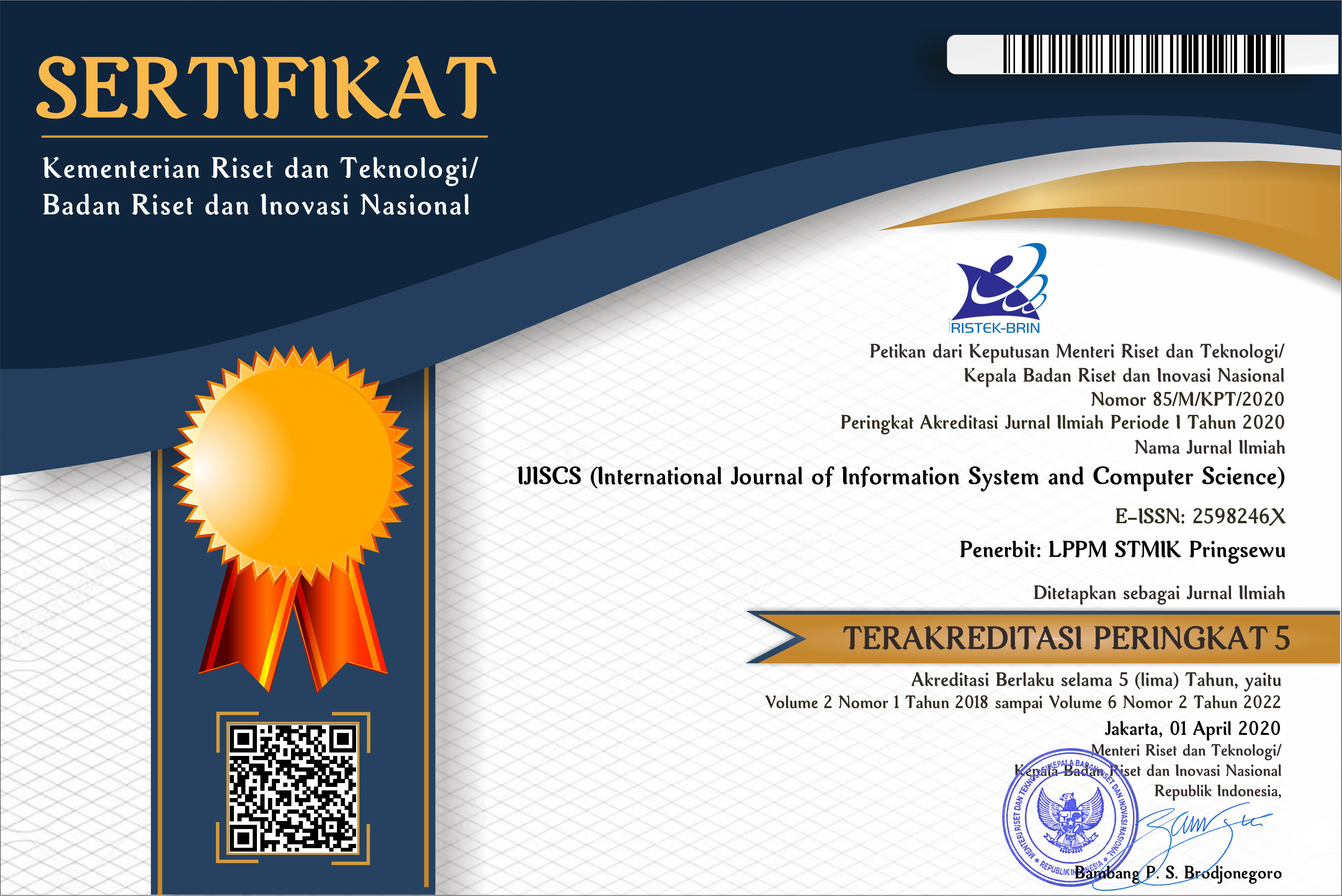INTRUSION ALARM SYSTEM BASED ON RADIO FREQUENCY TECHNOLOGY, GPS, GSM AND DIJIKSTRAT ALGORITHM FOR NOTIFICATION TRIANGULATION
(1) Departement of Mathematics, Statistics and Computer Sciences Faculty of Science and Technology, University of Kinshasa, Kinshasa
(2) Departement of Mathematics, Statistics and Computer Sciences Faculty of Science and Technology, University of Kinshasa, Kinshasa
(3) Departement of Mathematics, Statistics and Computer Sciences Faculty of Science and Technology, University of Kinshasa, Kinshasa
 Corresponding Author
Corresponding Author
Abstract
In today's world, cars are important products that are essential to life. But when it comes to vehicle security, it's hard to start. "Vehicle theft is on the rise. Most stolen vehicles are exported abroad. The aim of this research is to develop a remote sensing notification module. In the event of a break-in, the driver is notified by SMS using GSM technology, uses GPS to track the location of the vehicle and trace the route, maps the location and uses the DIJIKSTRAT algorithm to find the nearest send a notification to the police station. The module also incorporates a prediction system for suspicious events associated with an infrared sensor. The overall idea of this research is to use large amounts of information and suspicious movements to develop a scientific model for intrusion detection. When a person approaches a parked vehicle, infrared sensors detect and compare suspicious movements in the knowledge base to detect possible intrusions. This paper proposes an anti-theft system to help car owners avoid theft and locate their car after it has been stolen. The materials referred to in this project are also actually designed.
Keywords
References
Manuel, “A Practical Design of Anti-Theft Car Protection System Based on Microcontroller,” Am. J. Appl. Sci., vol. 9, no. 5, pp. 709–716, 2012, doi: 10.3844/ajassp.2012.709.716.
Y. Irawan and R. Wahyuni, “Electronic Equipment Control System for Households by using Android Based on IoT (Internet of Things),” J. Phys. Conf. Ser., vol. 1783, no. 1, 2021, doi: 10.1088/1742-6596/1783/1/012094.
M. Laas-Bourez, D. Coward, A. Klotz, and M. Boër, “A robotic telescope network for space debris identification and tracking,” Adv. Sp. Res., vol. 47, no. 3, pp. 402–410, 2011, doi: 10.1016/j.asr.2010.09.010.
N. Kiruthiga, L. Latha, and S. Thangasamy, “Real time biometrics based vehicle security system with GPS and GSM technology,” Procedia Comput. Sci., vol. 47, no. C, pp. 471–479, 2015, doi: 10.1016/j.procs.2015.03.231.
S. Rana, R. Mewari, and L. Nautiyal, “Anti-theft security system for vehicles,” Int. J. Eng. Technol., vol. 7, no. 4.12 Special Issue 12, pp. 42–46, 2018, doi: 10.14419/ijet.v7i4.12.20990.
S. A. A. K. Montaser N. Ramadan, Mohammad A. Al Khedher, “An efficient automotive security system is implemented for anti-theft using an embedded system occupied with a Global Positioning System (GPS) and a Global System,” Int. J. Mach. Learn. Comput., vol. 2, no. 1, pp. 88–92, 2012, [Online]. Available: http://ijmlc.org/papers/94-T043.pdf
K. A. Mamun and Z. Ashraf, “Anti-theft vehicle security system with preventive action,” 2015 2nd Asia-Pacific World Congr. Comput. Sci. Eng. APWC CSE 2015, pp. 1–6, 2016, doi: 10.1109/APWCCSE.2015.7476241.
J. Arellano-Zubiate, J. Izquierdo-Calongos, and L. Andrade-Arenas, “Design of an Anti-theft Alarm System for Vehicles using IoT,” Int. J. Adv. Comput. Sci. Appl., vol. 12, no. 12, pp. 844–853, 2021, doi: 10.14569/IJACSA.2021.01212102.
T. Erlina, “Sistem Monitoring Suhu, Kelembaban Dan Gas Amonia Pada Kandang Sapi Perah Berbasis Teknologi Internet of Things (Iot),” J. Inf. Technol. Comput. Eng., vol. 1, no. 01, pp. 1–7, 2017, doi: 10.25077/jitce.1.01.1-7.2017.
M. Zeyad, S. Ghosh, and S. M. M. Ahmed, “Design prototype of a smart household touch sensitive locker security system based on GSM technology,” Int. J. Power Electron. Drive Syst., vol. 10, no. 4, p. 1923, 2019, doi: 10.11591/ijpeds.v10.i4.pp1923-1931.
S. Faruque and S. Faruque, Radio Frequency Modulation Made Easy. 2016.
H. Dong, X. Wang, C. Zhang, R. He, L. Jia, and Y. Qin, “Improved Robust Vehicle Detection and Identification Based on Single Magnetic Sensor,” IEEE Access, vol. 6, no. c, pp. 5247–5255, 2018, doi: 10.1109/ACCESS.2018.2791446.
X. Li, Q. Tan, L. Qin, X. Yan, and X. Liang, “Novel Surface AcousticWave Temperature–Strain Sensor Based on LiNbO3 for Structural Health Monitoring,” Micromachines, vol. 13, no. 6, 2022, doi: 10.3390/mi13060912.
F. Sol, M. La, and N. Do Si, “Mathématiques du GPS”.
“Le plus court chemin d ’ imposition des multinationales : application de l ’ algorithme de Dijkstra”.
Article Metrics
Abstract View : 77 times
: 77 times Download : 5 times
Download : 5 times
DOI: 10.56327/ijiscs.v7i1.1436
Refbacks
- There are currently no refbacks.






